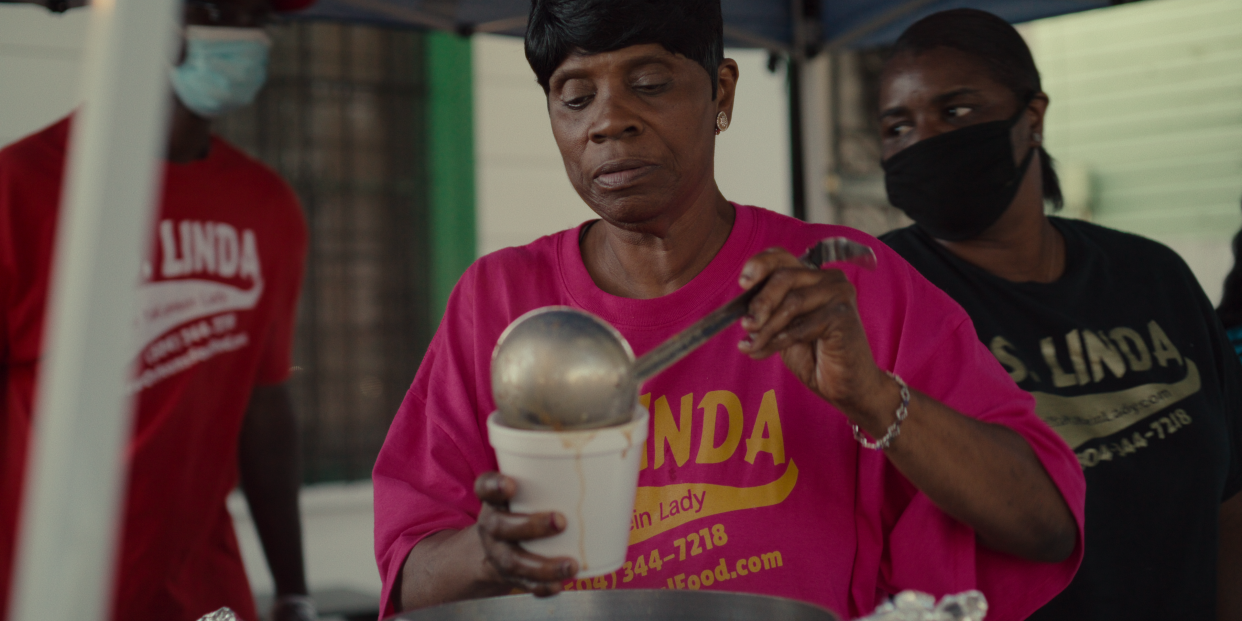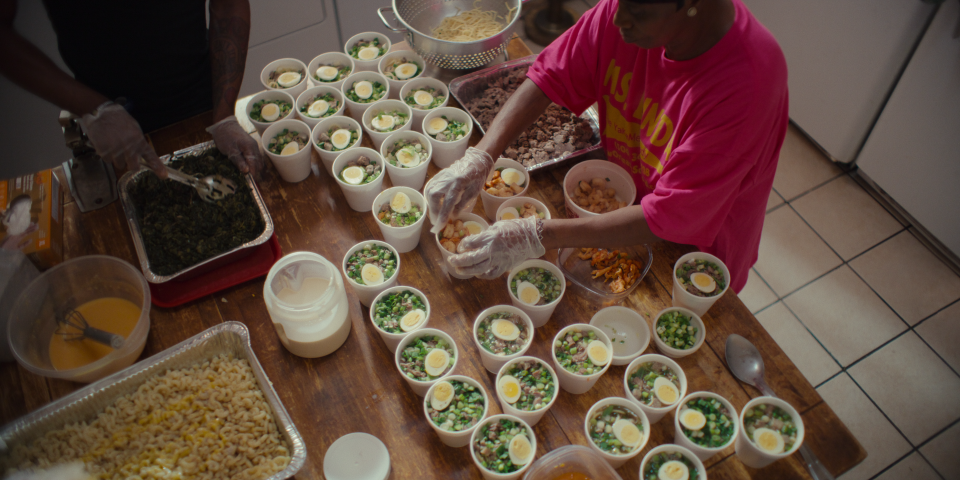Netflix's 'Street Food: USA' shines light on yakamein, New Orleans' 'best kept secret'

- Oops!Something went wrong.Please try again later.
Linda Green learned the secret recipe from her mother, Shirley. And Shirley got it from her own mom.
The dish is called yakamein, and it sounds simple. A cup of spaghetti noodles with beef topped with an egg, green onion and a dash of soy sauce. It all floats in a rich, dark broth that Green calls the "juice."
"It's one of New Orleans' well, best kept secrets," Green said. "It's really, really about the juice. The juice is the last part you put in the bowl, and it flavors everything in the bowl."
Others, like New Orleans' celebrated chef Nina Compton of Compère Lapin restaurant, are loftier in their description of Green's yakamein.
"It's like a bowl of love," Compton said.

With her boundless energy and optimism, Green has become synonymous with yakamein, which has deep roots in the city's Black community. Most people in New Orleans know her as Ms. Linda "the Yakamein Lady."
"You have that sense of hospitality, even though it's just being given to you in a food truck or a temporary space," said Liz Williams, founder of the Southern Food and Beverage Museum in New Orleans. "You have this sense that she's sharing this food with you."
Green sells her yakamein at New Orleans festivals, like Jazz Fest, the Gumbo Festival and French Quarter Fest. She follows second line parades, the neighborhood celebrations of community, and doles out cups to weary dancers in sharp outfits. She shows up at unexpected places with the dish, also known as "Old Sober," offering warm relief to those suffering after a long night.
Best of NOLA: These New Orleans restaurants serve a crossroads of delicious flavors
Now Green will share the story of yakamein with an audience beyond New Orleans in the latest season of the Netflix series "Street Food: USA," which debuts on the streaming service July 26. Previous seasons of "Street Food" have explored Asian and Latin America.
"It's extremely important to us to dig deep in each city and find the most authentic, truest characters who really represent it," said Suzy Beck, director of the New Orleans episode. "Every person asked us, 'Have you talked to Ms. Linda?'"
The New Orleans episode of "Street Food" also visits Hansen's Sno-Bliz for sweetened shaved ice, the corner spot Frady's One Stop for po'boy sandwiches and Mais La Seafood for spicy crawfish. Other episodes this season travel to New York, Portland, Oahu, Miami and Los Angeles.
"The impact of building a business brick-by-brick runs through nearly all our stories this season," wrote Brian McGinn, one of the show's executive producers, in an email. "It's so difficult to get the bravery to set out on a journey to do anything on your own. Now imagine cooking on the street, where you operate on low margins, worrying about bureaucracy, weather and attracting customers every single day."
Generations of yakamein makers
When Green's grandmother made yakamein, the aroma would drift down the block. Neighbors showed up with bowls and gathered on her porch.
"Oh, my God, it was so good," Green said.
Shirley, Green's mother, turned the recipe into a business.
Next door to their house in Central City was a bar called Bean Brothers, where Green's mother started selling yakamein.
"Everybody's having a good time, dancing and drinking and stuff," Green said. "And when it's time for them to go home, the first thing they do is get a yakamein."
Green's mother also made yakamein and other food for judges, her church and the Zulu Social Aid and Pleasure Club before it paraded on Mardi Gras. Green urged her mom to quit her job and make her living from yakamein. But Shirley, who died in 1995, stuck with her day job cooking for New Orleans public schools until, after 33 years, she retired.

Green followed her mother's path, working as a lunch lady for the schools and selling yakamein on the side. But Green found a way to take the family recipe to a wider audience.
On weekends in New Orleans, social aid and pleasure clubs, like the Black Men of Labor, the Lady Buckjumpers or the Money Wasters, take to the streets, dressed in brightly colored, matching suits. The men and women wave parasols and feathers, while moving to the beat of a brass band. Dancing crowds fall in behind the band, forming the "second line."
Vendors race from one stop along the parade route to another, selling hot sausage po'boys or grilled chicken. Green figured the crowds would be hungry for her yakamein, so she bought a camp stove to keep the "juice" warm, loaded all the ingredients into her black and gray Blazer, and hit the streets. Soon, at each stop, people were asking, "Where is the Yakamein Lady?"
When Hurricane Katrina hit in 2005, the New Orleans school system shut down. After more than 25 years as a lunch lady, Green lost her job. So she became the Yakamein Lady full time.
An American tradition
Street food vendors were once common in New Orleans and across the United States.
"From the Colonial period through the 19th century and into the early 20th century, street food vending is essential for how most cities fed their urban populations," said Ashley Rose Young, a Smithsonian Institution food historian.
The vendors, mainly Black women, sold fresh produce, praline candies and even beer.
'Fabulous' Lena Richard: In Jim Crow times, a Black woman chef from New Orleans built a food empire
Green carries on that tradition, although her dish, yakamein, was created in restaurants.
Yakamein was listed on Chinese restaurants menus from coast to coast as early as the first decade of the 20th century, according to the research of independent historian Winston Ho.
Ho, who is writing a book about yakamein, believes the dish, like chop suey and chow mein, was the result of Chinese immigrants trying to make familiar food with unfamiliar ingredients, like spaghetti noodles. As more Chinese ingredients reached the United States, yakamein vanished from most menus. Except at Chinese restaurants with African American customers, like in New Orleans or Virginia's Tidewater region, where their version is called "yock."
Over time, Black cooks made yakamein their own, adding salt and spices.
"It reminds me of Nigerian pepper soup," said Dillard University food scholar Zella Palmer about Green's yakamein. "We like peppery soups and soups are deeply part of Black traditions globally."

Keeping the recipe alive
In New Orleans, yakamein is no longer a secret. Other vendors sell it at second lines. High-end restaurants make fancy versions.
"Ms. Linda kind of put this on the map," Palmer said.
Other yakameins, though, do not taste like Green's.
"My mom's and my grandmother's yakamein had that old school flavor. Everybody had that flavor," Green said. "But what happened was a lot of people let their people die with that recipe."
Green has made sure that her family recipe will not disappear. She taught it to her daughters. Her grandchildren now also know how to make it. And Green shares with them all the lessons her mother taught her: Always cook for flavor, not for looks.
"If you cook for taste, they're going to come back. They're going to want more," Green said.
News tips? Story ideas? Questions? Call reporter Todd Price at 504-421-1542 or email him at taprice@gannett.com.
This article originally appeared on The American South: Netflix series 'Street Food: USA' highlights yakamein chef Ms. Linda

